High jump is one of the most ancient and natural types of athletics. Athletics in general is very organic and harmonious: running, jumping, throwing heavy objects were known to the first people on the planet.
In order to overcome the height, it is necessary to raise the center of gravity of the body above the bar. Or as close to the bar as possible. The center of gravity of the body of any person is located just below the navel, in the region of the second sacral vertebra. Or just above this vertebra. Women are a little lower. Depending on the structure of this body. ( Center of gravity- this, as you know, is the point relative to which the total moment of the forces of gravity acting on the system is equal to zero). Some have a much lower center of gravity, but they usually do not jump in height. And they hardly jump at all.
So, the whole one and a half century history of high jumps is essentially a search for the most effective options for transferring the center of gravity of the body above the level of the bar. If we leave aside the amusements of the German burghers of the early 19th century in the form of jumping over a stick with two feet forward, the whole evolution fits into five terms:
scissors - wave - roll - flip - flop.
Scissors jumped at first Olympic Games ah 1896
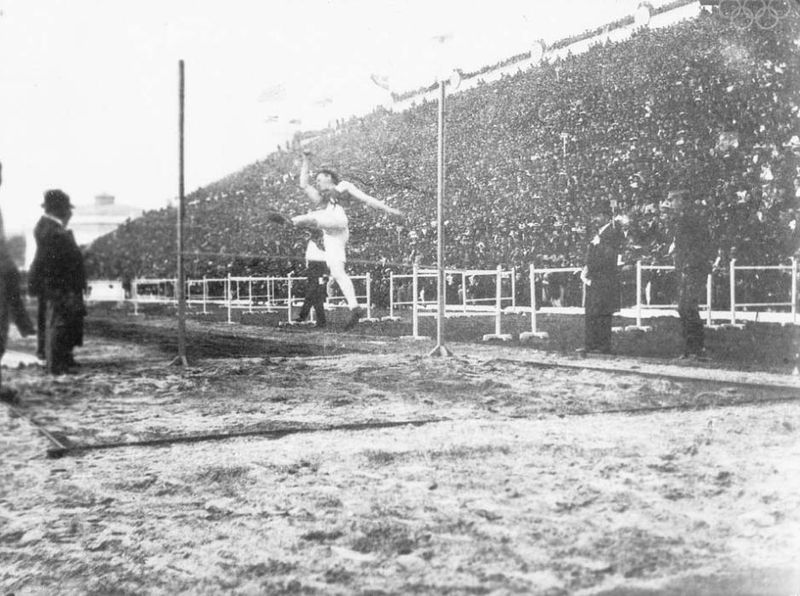
And an olympic champion 1908. also jumped with scissors:
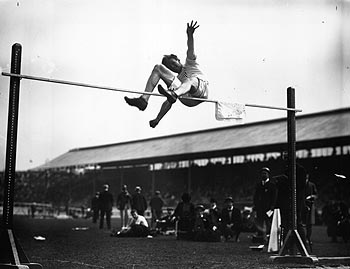
Olympic champion 1908 Gary Porter(USA) and his 1 m jump 90.5 cm
However, primitive scissors gradually evolved, and at the beginning of the century a "wave" appeared.
True, women continued to jump with scissors, for example, the 1928 Olympic champion (159 cm) Canadian Ethel Catherwood:
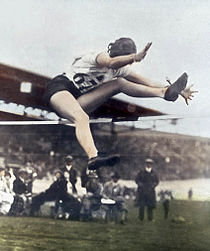
The author of the "wave" is George Horine, who was the first in the world to overcome 2 meters. At the 1912 Games he won a bronze medal. Actually, this style is named after him. Horine crossed the bar sideways, running towards it at right angles.
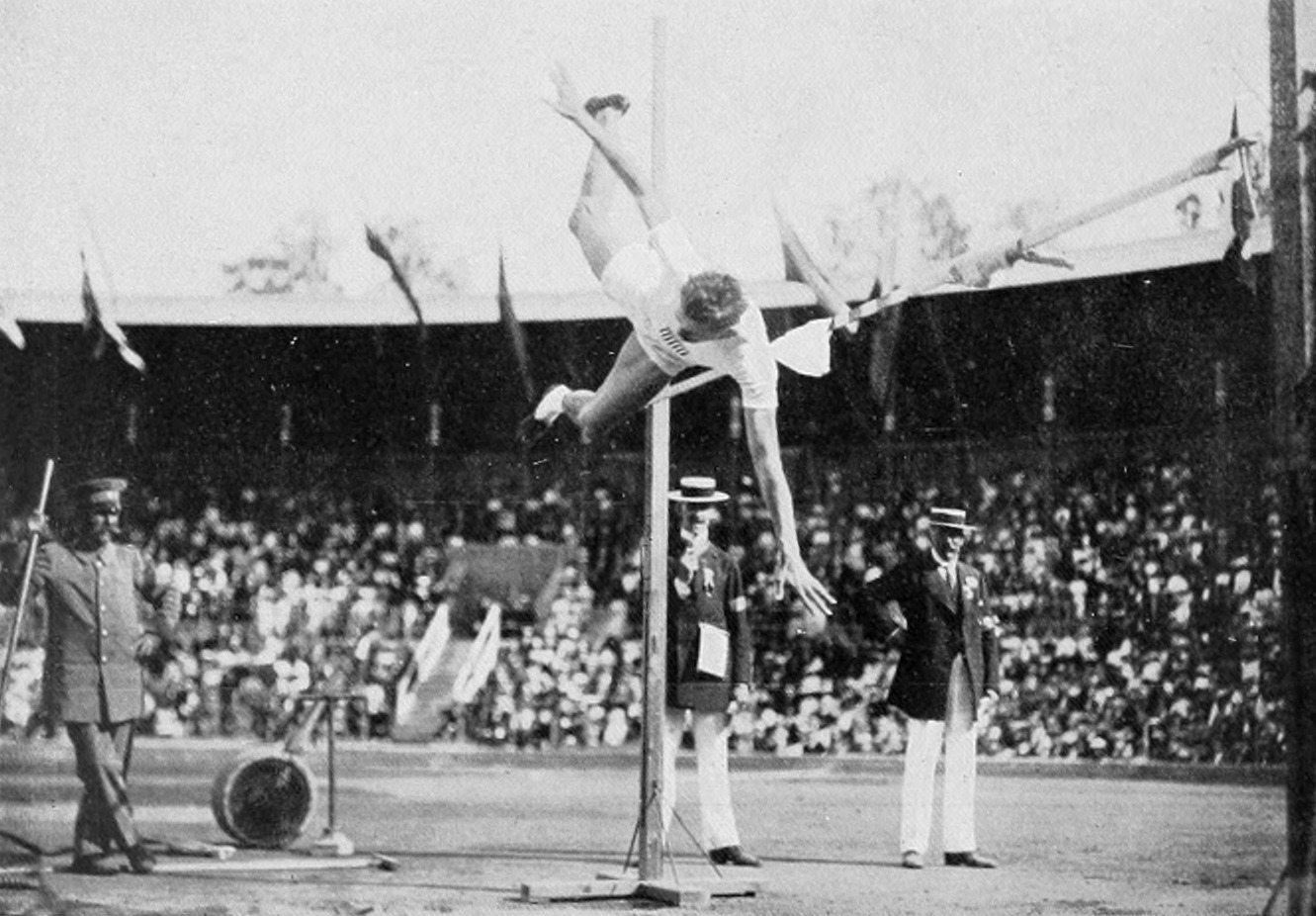
George Horine, bronze medalist at the 1912 Games
Most bright representative, more precisely, the representative of the "horaina" - an outstanding Romanian jumper Yolanda Balash, Olympic champion in 1960 and 1964:

She jumped with this style, when everyone in the world had long since switched to the "flip-over", and her world record (191 cm) lasted almost 10 years.
The development of the technique of high jumps was hampered by the rule, according to which the bar had to be crossed first with the feet, and only then to transfer the rest of the body. This rule was abolished in 1925, and in the 1930s. the "roll" style appeared. The athlete runs up to the bar at an angle from the side of the jogging leg, pushes off, crosses the bar and lands on the jogging leg.
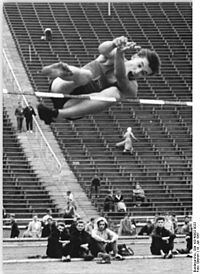
In the late 40s and early 50s, most Soviet high jumpers jumped this style and could not overcome 2 meters in any way. Meanwhile, the strongest jumpers in the world have long and successfully mastered the flip style. Back in 1941, jumping "crossover" (or "straddle"), the American Steers took 211 cm, setting a world record. The difference between "flip" and "roll" is as follows. The run is the same as during the “roll”, but the athlete pushes off with the foot closest to the bar and lands on the fly leg. Going through the bar successively with a swing and then a push leg, with a bent body position and a deep “dive” head down behind the bar, lowers the center of gravity (center of mass of the body) below the level of the bar. Compared with the "scissors" this gives an advantage of almost half a meter.
Development Soviet school high jump is inextricably linked with the name of Professor Vladimir Dyachkov. Himself in the past a wonderful athlete, repeated champion of the USSR, Dyachkov developed a methodology for teaching "flip" and began to "introduce it to the masses." If the bronze medalist of Melbourne-1956 Igor Kashkarov was still jumping in a roll, then already in 1957 Yuri Stepanov set a world record - 216 cm. .
However, the record was still ratified, and then the era of Soviet high-altitude athletes began. It began with the Games in Rome, when Robert Shavlakadze, who retrained from a roll to a flip, won the Olympic champion title with a score of 216 cm, ahead of 18-year-old Valery Brumel in attempts.
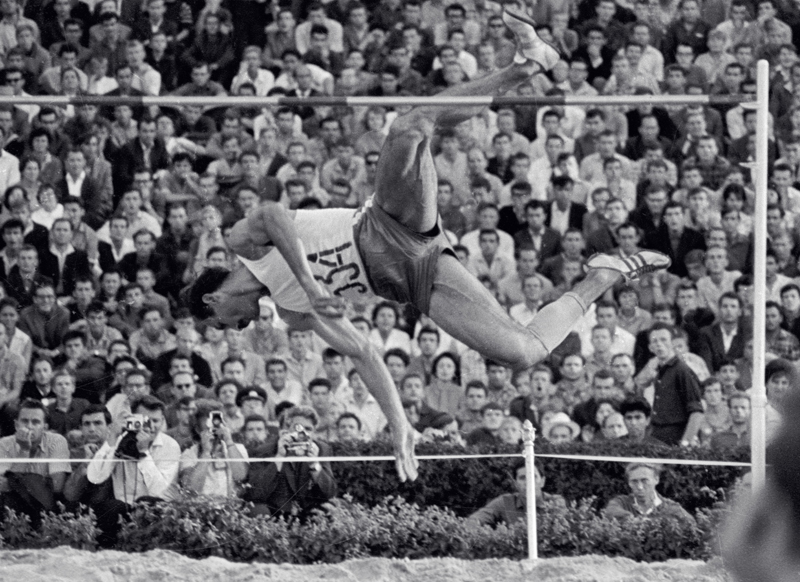
The world record holder American John Thomas remained third (214 cm), again ahead of the third Soviet jumper Viktor Bolshov in attempts.
And then began a series of victories and records Valeria Brumelya.
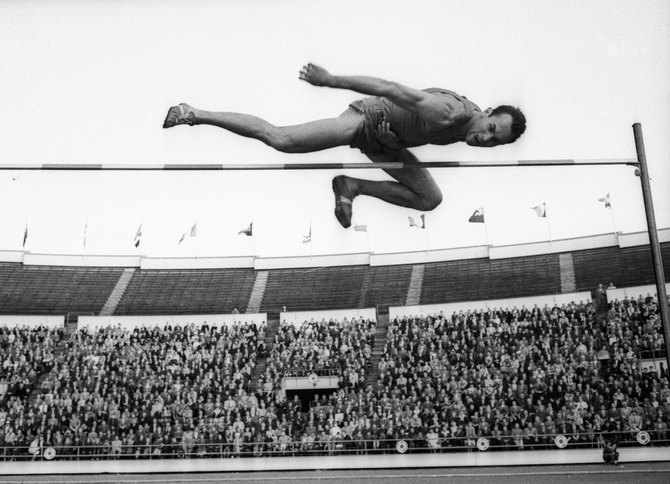
Pay attention to the number of viewers. Everyone went "to Brumel."
Everything seemed calm in the hopping world. The basic characteristics of a high jumper, training methods have been worked out ...
Until 1968, the high jump had evolved: straight-body scissors, wave, roll, and flip-over with a slope facing the bar. In 1968 there was revolution: Dick Fosbury, running up to the bar at a right angle, crossed it with his back and landed on his back.

in Mexico City Richard Fosbury took 224 cm and became the Olympic champion. The flop epidemic has swept the world. And only our sports leaders were skeptical about the new style. The same Dyachkov called the flop almost a circus and said that it suits only its author. However, the world record of another American, Patrick Matzdorf, proved that the flop has no less right to exist than the flip. For some time, supporters of both styles competed on an equal footing. So, in 1972, the gold in Munich was won by the “flip-flop” Juri Tarmak. However, our jumpers successfully mastered the flop.
The last "king of the flip" was the fantastically talented and quickly burned out Vladimir Yaschenko- 235 cm.
Today the flop won a total victory. It allows jumpers of completely different physical parameters to achieve outstanding results. For example,
Andrey Silnov, Beijing Olympic champion, typical high-altitude climber,
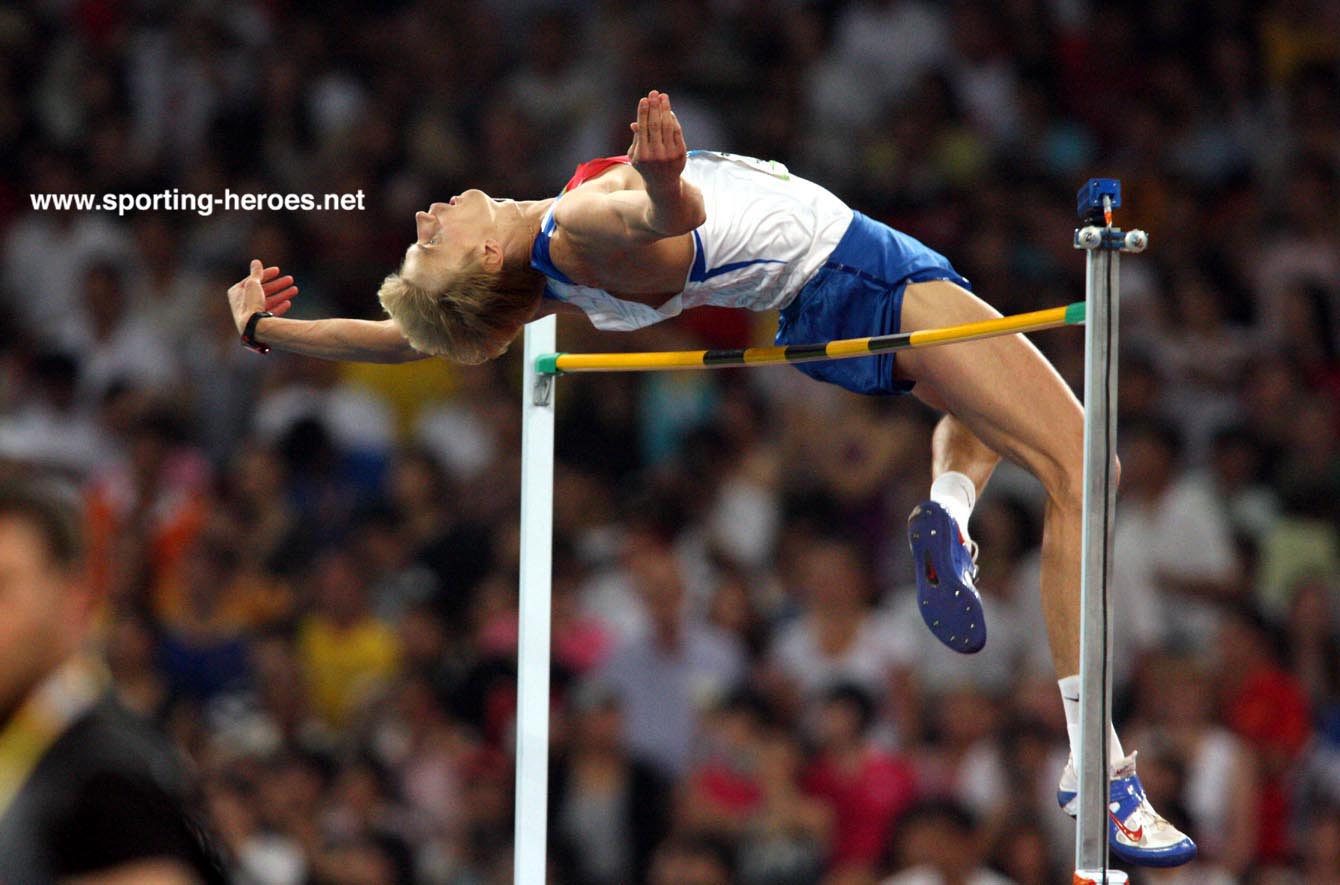
Ivan Ukhov, London Olympic champion, more like a shot putter
And again everything is calm in the hopping sky: flop and only flop.
This season, not just a few, like Igor Paklin or Javier Sotomayor, have reached the 240 cm line, but a whole group of brilliant jumpers: Ivan Ukhov, Derek Dryuin, Murtaz Barshim, Bogdan Bondarenko, and several more are on the way.
Diamond League Stage. Doha 2014
However, the stage in New York made a splash. For the first time in the history of athletics, an athlete who overcame 242 cm took second place! It turned out to be Murtaz Barshim, who lost to Bogdan Bondarenko on attempts.
Murtaz Barshim and Bogdan Bondarenko
Today the flop looks like a completely organic high jump style. It seems that it is simply impossible to jump otherwise.
And yet it's interesting how will they jump after the flop?
The history of the high jump is comparatively short. In the Olympic Games of antiquity, there is no mention of competitions in this type. Only in early XIX V. in German turnfereins, a gymnastic jump from a direct run appeared. At the same time, none of the jumps has undergone such changes in technique as in high jumps. Five varieties in this type of jump - "stepping", "wave", "roll", "flip", "fosbury flop" - have passed a relatively short historical path.
The first officially registered result in high jumps in 1864 was 167 cm. Moreover, the takeoff and landing were made on grass. Athletes jumped from a straight run, crossed the bar, pressing their legs, or jumped at an acute angle, performing leg movements with “scissors”. Subsequently, this style was called "stepping over". In 1887, the American W. Page set the first world record - 193 cm.
A significant step forward in the search better style made it possible to create an East American way of jumping (“wave”), by which the American M. Sunney in 1896 set a world record that lasted 16 years - 197 cm. a new style jump - "horain", named after the American jumper D. Horain, who first showed this style. Later, the style was called "roll".
In 1936, D. Olbritton demonstrates new way crossing the bar - lying with your stomach to it. Interestingly, back in the 20s. of the same century, B. Vzorov used this method of jumping, but did not receive worthy attention. This style was called "cross over". In 1941, the American L. Steers set a world record - 211 cm - in a "flip" way. In 1957, the Soviet athlete Yu. Stepanov set a new world record - 216 cm, interrupting more than seventy years of hegemony of American athletes. And since 1961, the record passed to the wonderful Soviet jumper V. Brumel, who jumped in the "flip" style, and amounted to 228 cm.
In 1968, at the Olympic Games in Mexico City, R. Fosbury (USA) demonstrated a new way of crossing the bar - lying on his back, while winning a gold medal. Nowadays, all jumpers and jumpers use this jumping style, as it has been scientifically proven to be effective over all other jumping styles.
To date, the world record in high jump for men belongs to X. Sotomayor (Cuba) - 245 cm, for women - S. Kostadinova (Bulgaria) - 209 cm, jumping in the Fosbury-flop style.
The high jump from a running start is a coordination-complex sport that places high demands on the physical capabilities of athletes. Conventionally, this jump can be divided into four main structural phases: 1) run-up, 2) repulsion, 3) crossing the bar and 4) landing.
List of used literature:
- Zhilkin A.I. etc. Athletics: Proc. allowance for students. higher ped. textbook institutions / A.I. Zhilkin, V.S. Kuzmin, E.V. Sidorchuk. - M.: Publishing Center "Academy", 2003. - 464 p.
n1.docx
Introduction.The high jump with a run is an athletics discipline related to vertical jumps of technical types. The components of the jump are the run-up, preparation for repulsion, repulsion, crossing the bar and landing.
Requires jumping ability and coordination of movements from athletes. Held in the summer and winter season. It has been the Olympic athletics discipline for men since 1896 and for women since 1928.
Rules.
High jump competitions take place in a jumping area equipped with a bar on holders and a place for landing. The athlete at the preliminary stage and in the final is given three attempts at each height. The athlete has the right to skip a height, while unused attempts at a missed height do not accumulate. If an athlete has made an unsuccessful attempt or two at any height and does not want to jump any more at that height, he can carry over the unused (respectively two or one) attempts to the next heights. The increase in height during the competition is determined by the judges, but it cannot be less than 2 centimeters. An athlete can start jumping from any height, after informing the judges about it.
The distance between the bar holders is 4 m. The dimensions of the landing area are 3 x 5 meters.
When trying, the athlete must push off with one foot. An attempt is considered unsuccessful if:
As a result of the jump, the bar did not stay on the racks;
The athlete touched the surface of the sector, including the landing site, located beyond the vertical projection of the near edge of the bar, or between or outside the uprights with any part of his body before he cleared the bar.
A successful attempt is marked by the referee by raising the white flag. If the bar falls off the posts after the white flag is raised, the attempt is considered valid. Usually the judge fixes the taking of the height not earlier than the athlete left the landing place, but the final decision on the moment of fixing the result formally remains with the judge
Jumping.
A jump is a way to overcome horizontal or vertical obstacles. Jumps are performed from a place or from a run. In athletics, high jumps from a run, long jumps from a run, triple and pole jumps are widely used. The purpose of jumping is to teach the athlete to jump as high and as far as possible. To do this, students are introduced to theoretical foundations jumping techniques in general and on the basis of this knowledge master the technique of the chosen jump.
In jumps, four successive phases are clearly visible - take-off, repulsion, flight and landing. The effectiveness of all jumps is set by the speed of the take-off and the force of repulsion.
The run in jumps is made with acceleration in order to achieve the highest speed in the last steps. The foot is placed in the place of repulsion quickly and energetically.
Repulsion is made by the strongest (jogging) leg. This is the most important phase in jumping. At the moment of contact with the ground, the jogging leg, experiencing a large load, shock absorbing, bends and resembles a compressed spring. The repulsion consists in the fact that the jumper instantly straightens it, vigorously pushing off the support. In this case, the leg should be fully extended. The repulsion effect is enhanced by the rapid raising of the arms and the fly leg. The role of the fly leg in jumping is very large due to the great strength of its muscles and mass, as well as big way her movements. The angle of repulsion during jumps is different: it is greater for high jumps and less for long jumps.
In the flight phase, the jumper's body moves along a trajectory given by the takeoff speed and repulsion force, experiencing the action of gravity and air resistance.
High jump technique
In practice, there are several ways of jumping, in height from a running start: “stepping over”, “rolling over”, “wave”, “overlapping”, “fosbury flop”. The most effective in sports are considered to be "flip" and "fosbury flop".
Jumping in the way of "stepping over". The takeoff starts from the side at an angle of 30-45 °. Repulsion is performed with the foot farthest from the bar. First, the fly leg is transferred through the bar, and then, when the fly leg drops below the bar, the push leg is transferred. In this case, the body leans forward to the bar. The push leg is carried through the bar in an arcuate motion with the foot turned outward. This helps to turn the torso towards the bar and move the pelvis behind it. The jumper lands on the fly leg, face to the bar or sideways.
Jump in the "flip" way considered one of the most effective. It is used by many of the strongest jumpers. The run with this method is performed from the side of the jogging leg at an angle of 25-30 ° and consists of 7-9 running steps. Active run: running steps are continuously lengthening, running speed is increasing; the jumper, as it were, “runs with his feet forward”, significantly ahead of his shoulders. The last three steps before repulsion are most important: the longest is the penultimate one, it is 10-20 cm longer than the previous one, the last step is 30-40 cm shorter than the penultimate one. The pushing leg is brought to the place of repulsion, first with the knee forward, then with a quick movement of the lower leg it sharply unbends and almost straight is placed from the heel to the ground. Hands with a simultaneous movement through the sides are retracted.
The repulsion consists of a quick and complete extension of the pushing leg, straightening of the torso and active lifting of the shoulder girdle, arms and swing leg in an forward-upward arc. Under the weight of the body, the pushing leg slightly bends. The fly leg, bent at the knee joint, passing by the push leg, straightens and drags the pelvis along with it. The push leg rolls from heel to toe instantly straightens, pushing the body up. A quick swing of the arms along with the swing leg greatly increases the efficiency of the repulsion. Both the height of the jumper's take-off and the coordinated transition over the bar largely depend on the coordinated swing of the arms and the fly leg.
At the moment of crossing the bar, the body of the jumper is in a horizontal position with his chest down to the bar. The fly leg turns toe inward and falls behind the bar. The bent push leg is retracted to the side, bending around the bar. The successful transfer of the take-off leg largely depends on the rotation that the body of the jumper receives from the “dive” with his head behind the bar.
Landing occurs on the shoulder and back. When jumping in this way, you cannot jump on the sand, you must have a high soft “cushion” at the landing site. This warning applies even more to the Fosbury Flop, which lands on the back, neck, and head.
The sequence of studying and improving the technique of running high jumps depends on the method of the jump, the preparedness of the athlete, the availability of conditions, etc.
The following exercises can be recommended for self-improvement of the jumping technique by the “stepping over” method.
Definition of the push leg.
Improving the technique of takeoff and repulsion.
Jumping over the bar from a place, from one and three running steps.
Marking the run of 7-9 running steps (make control marks for 3-5 steps and at the place of repulsion).
Improving the technique of crossing the bar from three steps and from a full run. Jumping for results.
To improve the technique of jumping, to educate the physical qualities necessary for a jumper, we can also recommend a number of special exercises high jumper. You can include them in your self-training plan.
The tactical preparation of the jumper for the competition is integral part his workouts. It is very important to cultivate the ability to quickly and correctly assess the current situation, to show independence. To do this, you need to know your opponents and correctly assess your capabilities.
When determining a place in high jump competitions, the initial height and the number of attempts spent are taken into account. Therefore, it is necessary to strive to overcome the height on the first attempt and show the best result with the least number of attempts. In competitions, an athlete must start jumping from such a height that his highest performance falls on jumps of the maximum height. Experienced jumpers show their maximum capabilities on the seventh or eighth jumps. Therefore, it is advisable to start the competition with a jump 20-25 cm below your limit. At failed attempt you need to calmly analyze the failed jump, find the error and try to correct it in the next jump.
Literature used in the abstract:
1. Voinova, S.E.
Basic sports: athletics: Tutorial/ S.E. Voinova, M.Yu. Shchennikova, V.E. Lutkovsky, A.B. Yankovsky; National state Univ. Culture, sports and health them. P.F. Lesgaft, St. Petersburg. - St. Petersburg: [b.i.], 2010.-99-102 p.
2. Dyachkov V.M.
High jumps / V. M. Dyachkov. - M.: Physical culture and sport, 1966. - 119 p. : ill. - (B-chka athlete).
TEST
"Classification of types of jumps. High jump training"
Introduction
Jumping is a simple and natural way to overcome obstacles. Depending on the nature of these obstacles, high jumps, long jumps, and later with a pole and a triple jump appeared.
It is difficult to overestimate the importance of jumps in the physical improvement of a person, and especially in the physical education of the younger generation. Jumping exercises are necessary for a growing body, they perfectly develop the muscles of not only the legs, but also the back, abdominals, lumbar region, improve the neuromuscular reaction, and contribute to the improvement of physical qualities - speed, strength, agility, not to mention this specific quality like jumping ability. Jumping develops an eye, coordination and accuracy of movements.
I believe that the role of jumps is also great in educating the moral and volitional qualities necessary for a teenager and youth - courage, determination.
1. The history of the development of jumps
Long jump competitions were included in the program of the Olympic Games Ancient Greece as one of the types of pentathlon (pentathlon). Nowadays, the long jump is included in the program of any athletics competition.
High jumping appeared in Europe at the beginning of the 19th century. Pole vault competitions were first held in England in the middle of the last century. Ireland is considered the birthplace of the triple jump, where the first competition in this type of athletics took place in the second half of the 19th century. All these types of jumps are included in the program of the modern Olympic Games.
2. Classification of types of jumps
There are four types of jump in athletics: long jump, high jump, triple jump and pole vault. The first two jumps are performed without intermediate support. IN triple jump There are two intermediate supports. In the pole vault, the athlete uses a moving support - a pole.
Depending on the type of obstacle, the jump is performed in length or height. Each of the jumps has options that are performed different ways. In any of the types of jumps, the phases of take-off, repulsion, flight and landing are distinguished. If in the long jump, high jump and pole vault there is a one-time repulsion, then in the triple jump the athlete repels three times, making three consecutive jumps (“leap”, “step” and “jump”).
3. Jumping into different age stages
In the first grades of the school, the program does not provide for teaching jumping as athletics exercises, but getting to know repulsion, jumping on various objects, jumping over them, games with jumping elements are occupied in the lessons physical culture a significant place, positively affecting the strengthening of the musculoskeletal system, preventing the appearance of flat feet. Already here it is necessary to acquaint children with the simplest forms of jumps available to them.
In grades V-VI, students begin to master long jumps by “bending their legs”, in a step, in height - by “stepping over” from a straight and side run. In parallel with this, they practice in overcoming vertical obstacles up to 50 - 80 cm high and horizontal obstacles up to 1.5 - 1.7 m long.
IN 7th grade students improve the performance of long jumps and heights in sports ways, study the take-off, repulsion.
Up to 13-14 years of age, the differences between boys and girls in learning to jump are in some cases not taken into account. However, from this age, it is necessary to take into account the developmental features of girls, as they begin to yield to boys in speed-strength qualities.
In grades VIII-IX, training continues in long jumps with a run-up by the “bending legs” method (movements of arms and legs in flight) and high jumps - “stepping over” (crossing the bar and moving away from it). In a school for educational purposes, and in a youth sports school for the purpose of training and sports improvement, you can start initial training in the triple jump, strictly adhering to the principles of gradualness and accessibility.
In the senior classes, students improve sports methods of jumping, establish the most convenient individual run, and use the acquired jumping skills in difficult conditions. In the Youth Sports School, boys and girls at this age, as a result of mastering rational technology and achieving enough high level speed-strength preparedness are prepared to fulfill the standards of sports classification in jumping.
4. High jump technique
High jump - a natural and widespread form exercise. It is characterized by short-term powerful muscular efforts of an explosive nature.
With any method of high jump, its main phases are the run-up, repulsion, crossing the bar and landing. The Russian school of high jumps considers a jump as “a complex exercise consisting of several heterogeneous motor structures, characterized by a transition from cyclic movements in the run to acyclic movements in the phases of push and flight” (V. Dyachkov). For modern technology high jumps are characterized by a significant take-off speed, repulsion power and a rational transition of the bar with a low location of the body's BCT of the athlete,
Runaway and repulsion. The task of the run is to acquire the necessary horizontal speed by the jumper and prepare for the push. The takeoff angle depends primarily on the way the jump is made. With a "flip" the most favorable angle is 25 - 35 °. When "stepping over" and "rolling" it exceeds 35 - 45 °, and when jumping in the "wave" way, it is 75 - 90 °. On early stages training, a sharper takeoff angle is used - 15 - 25 °. It must also be borne in mind that the faster the run-up and the longer the flight, the sharper the jumper will have to take off at a sharper angle to the bar.
In all jump methods (Fig. 1), the run-up must be straight, and the feet should be placed along the run-up line without turning the toes outward. Only V in the Fosbury method, the run is performed in an arc. The athlete starts running perpendicular to the bar, and then on the 3rd - 5th last steps of the run along the arc runs sideways to it. The run-up length usually does not exceed 7-9 running steps (11-14 m). In the Fosbury Flop jumps, the run-up must ensure that the athlete acquires the necessary speed by the time of repulsion. For beginners and schoolchildren, the run-up length will not exceed 5 steps at first. A run in 3 steps is used in training and is educational in nature.
Takeoff speed depends not so much on the method of jumping, but on the level of speed-strength fitness of the athlete, his ability to powerfully perform a push at a particular run-up speed. Athletes using the Fosbury method achieve the highest speed.
Start of run has several options. The most common - the athlete puts one foot behind, and the other in front, at the control mark. Another option - both legs are placed side by side on the same line. Finally, some jumpers start their run from the approach, i.e. take several accelerating steps and start the actual run-up at the moment when they step on the control line.
Rhythm is essential. The take-off speed should continuously increase, reaching its maximum value by the moment of repulsion. The run-up technique is characterized by a wide extension of the legs forward, with their elastic, active setting on the ground. Only the run of jumpers using the Fosbury method is not much different from the usual sprint run and run of long jumpers. The take-off speed increases in parallel with the increase in stride length.
IN run end, 2 - 3 steps before repulsion, a second control mark is made, and preparation for the push begins from it, or, as they say, to enter the push. The length of the last steps increases due to the wide extension of the free leg forward. The foot is placed on the ground from the heel. The longest is the penultimate step, the last one is somewhat shorter. Naturally, the length of the last steps of schoolchildren is much less. However, they also need to achieve the above ratio of steps preceding the push.
The last steps determine the success of the repulsion. The third step from the push is essentially a transition from the preliminary to the final part of the run. It runs faster than the previous steps. The foot is placed on the ground from the heel. The slope of the body is reduced. The second step from the fly leg determines the successful entry into the push. It is here that the pelvis, as it were, is brought under the shoulders, the torso takes a vertical position, and the leg is gently bent at the knee. BCT of the body is reduced. Hands through the sides are laid back.
After the jumper passes the moment of the vertical, with a wide running motion from the hip, an almost fully extended push leg is sent forward, which is placed on the ground from the heel, immediately moving to the entire foot. After short period flexion in the knee joint, the push leg begins to unbend. The repulsion is facilitated by the extension of the torso and the swinging movement of the free leg and arms. At the end of the push, which will be followed by the lift of the athlete from the ground, the push leg and torso are straightened, the arms and swing leg are raised up.
Jumpers, as a rule, use a simultaneous parallel swing with their arms previously laid back. The swinging movement of the arms is performed with the elbows forward and ends at the level of the shoulders - the head. At the beginning of the swing, the leg moves up from the hip. Following this, the shin and leg are brought up, partially or completely straightened. With good mobility in the hip joint, it is possible to perform a swing with a fully extended leg. However, with modern significant take-off speeds, even the best jumpers can perform a swing with a bent leg.
Determination of the place of repulsion depends on the angle of take-off and the method of jump. The sharper the angle of take-off, the closer the place of push to the bar and the more favorable the conditions for performing rotation in flight (for the “roll” and “flip” methods). Everything said about the run-up and repulsion applies to all methods of jumping, except for the “fosbury”. In addition to the peculiar conduct of the run, it differs from other methods and the nature of repulsion.
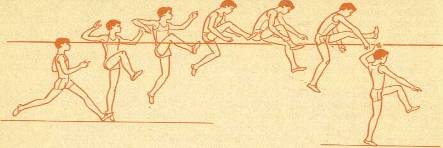
Flight and landing. The movements of an athlete in flight depend on the method of jumping used by him. “Stepping over” (Fig. 2) is the easiest way to master, which is used at the initial stages of education and which is most often dealt with by a teacher of physical education at school. The run is performed at an angle of 35 - 45 0, and repulsion is 50 - 80 cm from the bar. The jumper is sideways to the bar and, performing a push with the foot farthest from the landing pit, then makes a wide swing with his free leg and arms. During take-off, the push leg is freely lowered down for some time, and then, bending the knee up, is pulled up to the bar. The body occupies a vertical position, and at the end of the take-off, it leans forward a little - inward. Hands drop down on both sides of the bar. Stepping movements consist in the fact that the swing leg with an energetic movement falls down behind the bar, and the push leg, unbending at the knee, is transferred over the bar with an outward turn. At the same time, the trunk turns towards the pushing leg.
Landing is carried out on the fly leg sideways to the bar. When crossing the bar, it is extremely important to avoid dropping the shoulders back, as this will lower the center of gravity and make it difficult to transfer the legs over the bar.
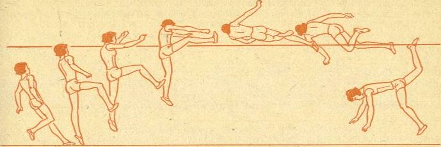
The "roll" method(Fig. 3) immediately preceded the appearance of the "flip" way of jumping. The run-up in the “roll” is performed at an angle of 35 - 45 °, and repulsion is 80 - 100 cm from the bar with the foot closest to it. The jumper makes an energetic swing with his free leg and, lying sideways on the bar, pulls the push leg to it. The body of the jumper, already in repulsion, receives an impulse to rotate along the bar. Pulling up to the chest of the push leg and lowering the bar of the fly leg eponymous hand promotes rotation. As a result of this rotational movement along the longitudinal axis, the athlete turns chest down and lands on the pushing leg and arms.
The transition of the plank jumper has a number of options. The most effective is the so-called "dive", when the athlete quickly bends the body in the hip joints, as if diving with his head and shoulders over the bar. Landing ends with a roll to right side torso when pushing off with the left foot).
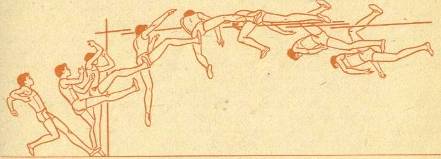
In a jump by way of "overlapping"(Fig. 4) the run-up is performed at an angle of 25 - 35 °. Some jumpers also use a sharper takeoff angle. Repulsion is performed 60 - 100 cm from the edge of the landing pit. "Flipover" jump is further development the “roll” method and has much in common with it. Repulsion is performed with the leg closest to the bar. The basis of further movements is the sequential transfer of the fly and push legs through the bar in the prone position to the bar.
Success in the "overlapping" way of jumping depends primarily on the push in combination with the movement of the fly leg, which, dragging the right side of the body with it, contributes to its rotation and transition to a horizontal position. Thus, the basis for the transition of the bar in the "flip" method of the jump is the longitudinal-transverse rotation of the body with its transfer to the position with the chest down towards the bar,
After repulsion, it is important not to lie down prematurely on the bar, but to fully use the lift generated by the push and swing. Finishing the push, the jumper stretches upwards for some time. Following this, he actively sends his right leg and shoulder to the bar, only gradually moving to a horizontal position. Rotation contributes right hand(if the repulsion is performed with the left foot), which moves more actively and with a wider amplitude than the left.
At the moment when the right hand is sent over the bar, and the torso rotates across it, the pushing leg is pulled up to the body and bent at the knee joint. The fly leg is extended along the bar. The jumper turns the pelvis along the longitudinal axis and, moving the pushing leg with his knee to the side - up, rolls over the bar. Overcoming the bar is facilitated by “dive” with the head and upper body. Landing occurs on the right shoulder with the transition to the back. A soft landing on the hands and the fly leg is also possible, followed by a roll to the shoulder and right side.
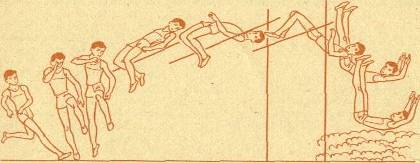
For fosbury method(Fig. 5) is characterized by an arcuate take-off and the transition of the bar with the back with a transverse position of the body of the jumper. The advantage of the method lies in the relative ease of the transition of the bar and the possibility of better use of the horizontal speed during repulsion.
Already the beginning of the run-up is characterized by greater than usual speed. In terms of technique and rhythm, it somewhat resembles the run of a long jumper and starts at an angle of 65 - 76 ° to the bar. The push is performed without the usual for “overlapping” method of lowering the body’s BCT with a slightly forward leg, which allows the jumper to more rationally use the horizontal speed obtained in the run.
Repulsion occurs when the athlete, after running sideways to the bar on the last 3-5 steps, is located sideways to it. He then turns his back to the bar and, as it were, lies on it, bending in the lower back. When the pelvis crosses the plank, the body of the jumper bends at the hip joints, and the legs are pulled up.
The difficulty of learning to jump in this way, especially in conditions secondary school, lies in the difficulty of landing. The jumper lands on his back, so special equipment is required - the landing site must be covered with a thick layer of foam rubber.
5. Learning the technique of high jumps
Before proceeding to the study of one or another method of jumping, students are introduced to the basics of the run-up and repulsion. The run-up must be studied in combination with repulsion. However, it is useful to perform a run without repulsion, with an increase in its length up to 7-9 steps. It is necessary to pay attention to the rhythm of the run, achieving its gradual acceleration. Quite often schoolchildren start to scatter too fast and reach the highest speed by the middle of the run. As a result, preparation for repulsion is carried out with a decelerating run, which entails a number of errors in repulsion. A significant mistake in the takeoff will be the premature lowering of the body's BCT, which will also hinder effective repulsion.
Run-up exercises should be combined with the study of the rhythm of the last three steps. The students are tasked with speeding up the rhythm of the last steps, performing them with a wide step, putting their foot on the ground from the heel. At the first stages, the run-up with the performance of the last pre-jog steps ends with either simply pushing away without overcoming the bar, or jumping onto low objects, as well as jumping over them in an arbitrary way.
Since the straightness of the run is one of the main conditions for the success of a jump, the teacher can set the task for students to run along a line drawn on the floor with chalk or a jump platform marked on the ground.
used to study repulsion big number special and imitation exercises: 1) setting the leg for a push from the heel to the entire foot; 2) swing with the free leg, holding the support with the hand; 3) a combination of setting a push leg with a swing of the free leg; 4) the same from a running start in combination with moving the arms back and then swinging the arms up; 5) the same with getting hands, head and foot of various objects; 6) jumping over the bar to take off, pulling up and bending the push leg, etc.
In the conditions of a general education school, when there are a significant number of students in the lesson, the teacher must also apply the methods of teaching the high jump technique, which allow all students to perform exercises simultaneously or in series. So, moving around the hall or playground at a distance of several steps from each other, children perform repulsion for every third or fifth step. Or, one after another, they jump over a rope stretched in the middle of the hall, a rope, rubber.
When performing bar jumps on a school playground, care should be taken to increase the landing pit so that several people can perform jumps at the same time. Such a long hole will also serve as a good help in teaching schoolchildren long jumps and triple jumps.
Already at the first stage of training, the teacher must instill in students the skills of rational landing. This will serve as deep jumps, jumping off various gymnastic equipment, learning to land on hands and feet, followed by a roll over to the shoulders and back.
When learning to run in combination with repulsion, it must be borne in mind that a jump is a single motor act, therefore great attention should be given to the combination of these elements. It would be rational to offer the trainees the following tasks: to combine a run with the last three accelerated steps, to complete the last three steps and imitate repulsion with an energetic swing of the free leg, etc. Children usually find it difficult to master the combination of a fast run-up with a powerful, technically correct repulsion. It is very important to find the optimal run-up speed for each student. Having found the appropriate run-up rhythm, it can be fixed by giving sound signals. The length of the individual takeoff steps can be adjusted by making appropriate marks on the takeoff line.
Breaking the bar. The movements of the jumper in flight depend on the method of jump chosen by him. Known a large number of simulation exercises with which you can master one way or another. However, if the teacher uses only them in the classroom, then he can “dry out” the lesson, make it uninteresting. That is why it is necessary to alternate the performance of special exercises with various jumps - not only through the bar, but also through natural and artificial obstacles, use games with elements jumps (“Fishing rod”, “Rope floor with legs”, “Jump after jump”, “Who will jump over whom?” - etc.), relay races with overcoming obstacles. In the process of training, competitions should be held both for the height of the jump (by the simplest methods) and for the best performance of its various elements.
Starting to study one or another way of jumping, the teacher needs to create a correct idea of his technique among the students. To do this, you can use photographs, cinematographs. However The best way It's still a practical exemplary show. After it, you need to invite students to perform a jump from an arbitrary take-off, fixing their attention on mistakes when pushing, crossing the bar, landing. Then go to learning the technique of jumping by the method of "stepping over" in the following sequence:
1. To teach to transfer the fly and push legs over the obstacle. To do this, standing sideways close to the obstacle (set at an oblique bar or bench), raise the fly leg up, put it behind the obstacle and immediately lift and move the push leg through it.
2. The same, but with several approach steps.
3. Teach how to overcome the bar by stepping over, starting from a small run. Mark the place of the push with a circle drawn 20–30 cm from the bar. Quickly approaching the bar with small steps, push off from the circle and overcome the obstacle. The same with three steps of a run.
4. Teach the correct movements of the fly and push legs. In addition to the take-off circle, draw a landing circle behind the obstacle. Performing a jump from a small run-up, try to straighten the fly leg above the bar and lower it with the turn of the foot and knee inward. At the same time, vigorously pull up and move the jogging leg over the bar,
5. Teach correct position torso and arms during the jump. Strive to straighten the torso and swing with arms bent at the elbows during the repulsion and tilt of the torso forward with turning it in the direction of the run-up, simultaneously lowering the arms down to the sides of the bar during the flight.
Mastering the "roll" method you should start by studying the run-up from the side of the pushing leg and repulsion with the leg closest to the bar. The following exercises contribute to this:
1. From a small run-up (2-3 steps), pushing off with the foot closest to the bar, pull it up to the flywheel. First, land on both feet, then on the fly and, finally, on the push.
2. Jump from 2 - 3 steps of the run, landing on the pushing leg and tilting the torso with a turn sideways to the bar.
3. The same, but pulling up, and then lowering the push leg over the bar and turning the chest to the landing hole.
4. Imitation of a jump using the “roll” method on the spot (“one” - swing your free leg, raise your arms up, “two” - changing the position of the legs, come to the grouping position above the bar).
5. Imitation of a jump over a horse or a gymnastic table.
Studying the jump in the "flip-over" method conditions of a comprehensive school has special meaning. This method is the most effective and at the same time relatively easy to learn. Its study does not require such precautions as "fosbury". Such exercises contribute to the development of the “flip-over” technique.
To study the longitudinal rotation of the body:
1. Standing on the push leg sideways to the gymnastic wall and holding on to it with your hands, performing a swing with a wide movement from the hip, followed by a turn to face the gymnastic wall.
2. The same exercise with several run-up steps. The exercise ends with a jump on the gymnastic wall.
3. Jumps from one, two and three takeoff steps with pulling up the pushing leg and increasing the speed of longitudinal rotation with a turn of 180 and 360° (pirouette).
4. The same, but through an inclination to the set bar. First, the far end of the bar is installed on the ground, and the near end is installed on the rack bracket. Gradually the far end rises.
To learn the movements when going over the bar and landing:
1. Imitation of the transfer of the push leg from the position of the emphasis lying behind the hands.
2. Performing the transition of the plank and landing with support on gymnastic equipment: a horse, a table, a bench, a log or bars.
3. Improving the transition of the bar and landing in the "flip" way, jumping over the bar set at an accessible height. Focus on the most poorly mastered elements of the jump technique.
To improve the jump by the "flip" method in general:
1. Jumping over the bar at an accessible height (increase the length of the run to 5, and then to 7 running steps). Improving the rhythm of the run, subject to the length and speed of the run available to each student.
2. Jumping over the bar. Improving the transition from run to push.
3. Jumps at near-limit and maximum heights (monitor the preservation of the technique of learned movements during the transition of the bar). Preparation of an athlete to mobilize the neuromuscular efforts necessary to overcome maximum heights.
Learning the technique of jumping using the Fosbury method, as already mentioned, it requires special equipment and precautions, so its development is possible only in the conditions of the Youth Sports School or in sectional classes in a comprehensive school.
Basic exercises for learning the Fosbury method:
1. Running in a circle with a gradual decrease in its diameter to 10 - 15 m.
2. Run with running along the turning arc on the last 3-5 steps.
3. Jumping over the bar using the "step over" method with running in an arc.
4. Performing repulsion and movement of a strongly bent fly leg forward and upward, directing it with the hip inward. The exercise is performed in place and then walking for every third step.
5. Performing a repulsion, followed by lowering the fly leg and turning back to the bar.
6. Lying on your back across the gymnastic horse, take the position of the entrance to the bar.
7. Lying with your back on the mats with your legs pulled up and bent, raise your pelvis up, as when crossing the bar, and then, lowering the pelvis, raise your legs up and straighten them at the knees, simulating the departure from the bar.
8. From a standing position with your back to the gymnastic horse, lean back and roll over the horse onto the mats placed high behind him, simulating the transition of the bar using the Fosbury method.
Only after doing these exercises repeatedly can you start jumping over the bar, ensuring a soft landing on your back. When mastering the technique of jumping by the “fosbury” method, in general, it is necessary to achieve an entrance to the push at a considerable speed, a run without squatting on the last steps, as is done in jumping by the “flip-over” method.
When teaching the technique of high jumps, schoolchildren often make mistakes that require immediate correction. Otherwise, a stable wrong habit is formed, which is already much more difficult to deal with. Errors appear on different phases jump.
The teacher needs to keep in mind that two main reasons contribute to the appearance of errors. The first is the wrong method of teaching the technique of jumping, the lack of a clear idea in children about certain elements of the technique. The second is insufficient general and special physical fitness interfering with the development of the technique of high jumps. Consequently, the correction of errors should include not only technical improvement, but also an increase in the level of speed-strength fitness, jumping agility, jumping ability, and repulsion power.
Conclusion
Mastering jumps at all stages of education and training should be accompanied by an increase in the level of general and special preparedness of students - the basis for the manifestation of maximum explosive efforts characteristic of jumping.
When training, especially at its initial stages, it is necessary to widely use games and various relay races with jumps. This, on the one hand, will bring the necessary emotionality into the learning process and will significantly increase the training load, and on the other hand, it will improve the coordination capabilities of children, teach them to control their bodies in flight, and help develop jumping courage and agility.









